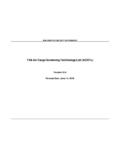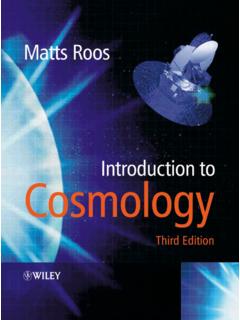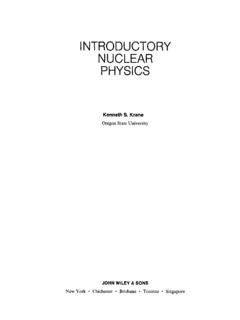Transcription of Lecture Notes on General Relativity - arXiv
1 arXiv :gr-qc/9712019v1 3 Dec 1997 Lecture Notes on General RelativitySean M. CarrollInstitute for Theoretical PhysicsUniversity of CaliforniaSanta Barbara, CA 1997 AbstractThese Notes represent approximately one semester s worth of lectures on intro-ductory General Relativity for beginning graduate students in physics. Topics includemanifolds, Riemannian geometry, Einstein s equations, and three applications: grav-itational radiation, black holes, and cosmology. Individual chapters, and potentiallyupdated versions, can be found ~carroll/ Notes /.NSF-ITP/97-147gr-qc/9712 019iTable of Contents0. Introductiontable of contents preface bibliography1. Special Relativity and Flat Spacetimethe spacetime interval the metric Lorentz transformations spacetime diagrams vectors the tangent space dual vectors tensors tensorproducts theLevi-Civita tensor index manipulation electromagnetism differential forms Hodge duality worldlines proper time energy-momentum vector energy-momentum tensor perfect fluids energy-momentum conservation2.
2 Manifoldsexamples non-examples maps continuity the chain rule open sets charts and atlases manifolds examples of charts differentiation vectors asderivatives coordinate bases the tensor transformationlaw partial derivativesare not tensors the metric again canonical form of the metric Riemann normalcoordinates tensor densities volume forms and integration3. Curvaturecovariant derivatives and connections connection coefficients transformationproperties the Christoffel connection structures on manifolds parallel trans-port the parallel propagator geodesics affine parameters the exponentialmap the Riemann curvature tensor symmetries of the Riemann tensor theBianchi identity Ricci and Einstein tensors Weyl tensor simple examples geodesic deviation tetrads and non-coordinate bases the spin connection Maurer-Cartan structure equations fiber bundles and gaugetransformations4.
3 Gravitationthe Principle of Equivalence gravitational redshift gravitation as spacetime cur-vature the Newtonian limit physics in curved spacetime Einstein s equations the Hilbert action the energy-momentum tensor again theWeak Energy Con-dition alternative theories the initial value problem gauge invariance andharmonic gauge domains of dependence causality5. More Geometrypullbacks and pushforwards diffeomorphisms integral curves Lie derivatives the energy-momentum tensor one more time isometries and Killing vectorsii6. Weak Fields and Gravitational Radiationthe weak-field limit defined gauge transformations linearized Einstein equations gravitational plane waves transverse traceless gauge polarizations gravita-tional radiation by sources energy loss7. The Schwarzschild Solution and Black Holesspherical symmetry the Schwarzschild metric Birkhoff s theorem geodesicsof Schwarzschild Newtonian vs.
4 Relativistic orbits perihelion precession theevent horizon black holes Kruskal coordinates formation of black holes Penrose diagrams conformal infinity no hair charged black holes cosmiccensorship extremal black holes rotating black holes Killing tensors thePenrose process irreducible mass black hole thermodynamics8. Cosmologyhomogeneity and isotropy the Robertson-Walker metric forms of energy andmomentum Friedmann equations cosmological parameters evolution of thescale factor redshift Hubble s lawiiiPrefaceThese lectures represent an introductory graduate course in General Relativity , both its foun-dations and applications. They are a lightly edited versionof Notes I handed out whileteaching Physics , the graduate course in GR at MIT, during the Spring of 1996. Al-though they are appropriately called Lecture Notes , the level of detail is fairly high, eitherincluding all necessary steps or leaving gaps that can readily be filled in by the reader.
5 Never-theless, there are various ways in which these Notes differ from a textbook; most importantly,they are not organized into short sections that can be approached in various orders, but aremeant to be gone through from start to finish. A special effort has been made to maintaina conversational tone, in an attempt to go slightly beyond the bare results themselves andinto the context in which they primary question facing any introductory treatment of General Relativity is the levelof mathematical rigor at which to operate. There is no uniquely proper solution, as differentstudents will respond with different levels of understanding and enthusiasm to differentapproaches. Recognizing this, I have tried to provide something for everyone. The lecturesdo not shy away from detailed formalism (as for example in theintroduction to manifolds),but also attempt to include concrete examples and informal discussion of the concepts these are advertised as Lecture Notes rather than an original text, at times I haveshamelessly stolen from various existing books on the subject (especially those by Schutz,Wald, Weinberg, and Misner, Thorne and Wheeler).
6 My philosophy was never to try to seekoriginality for its own sake; however, originality sometimes crept in just because I thoughtI could be more clear than existing treatments. None of the substance of the material inthese Notes is new; the only reason for reading them is if an individual reader finds theexplanations here easier to understand than those constraints during the actual semester prevented me from covering some topics inthe depth which they deserved, an obvious example being the treatment of cosmology. Ifthe time and motivation come to pass, I may expand and revise the existing Notes ; updatedversions will be available ~carroll/ Notes /. Of course I willappreciate having my attention drawn to any typographical or scientific errors, as well assuggestions for improvement of all people have contributed greatly both to my own understanding of generalrelativity and to these Notes in particular too many to acknowledge with any hope ofcompleteness.
7 Special thanks are due to Ted Pyne, who learned the subject along with me,taught me a great deal, and collaborated on a predecessor to this course which we taughtas a seminar in the astronomy department at Harvard. Nick Warner taught the graduatecourse at MIT which I took before ever teaching it, and his Notes were (as comparison willivreveal) an important influence on these. George Field offereda great deal of advice andencouragement as I learned the subject and struggled to teach it. Tam as Hauer struggledalong with me as the teaching assistant for , and was an invaluable help. All of thestudents in deserve thanks for tolerating my idiosyncrasies and prodding me to everhigher levels of the course of writing these Notes I was supported by Dept. of Energy con-tract no. DE-AC02-76ER03069 and National Science Foundation grants PHY/92-06867 of difficulty (especially mathematical) of the books isindicated by a numberof asterisks, one meaning mostly introductory and three being advanced.
8 The asterisks arenormalized to these Lecture Notes , which would be given [**]. The first four books werefrequently consulted in the preparation of these Notes , thenext seven are other Relativity textswhich I have found to be useful, and the last four are mathematical background references. Schutz,A First Course in General Relativity (Cambridge, 1985) [*]. This is avery nice introductory text. Especially useful if, for example, you aren t quite clear onwhat the energy-momentum tensor really means. S. Weinberg,Gravitation and Cosmology(Wiley, 1972) [**]. A really good book atwhat it does, especially strong on astrophysics, cosmology, and experimental , it takes an unusual non-geometric approach to the material, and doesn tdiscuss black holes. C. Misner, K. Thorne and J. Wheeler,Gravitation(Freeman, 1973) [**]. A heavy book,in various senses. Most things you want to know are in here, although you might haveto work hard to get to them (perhaps learning something unexpected in the process).
9 R. Wald, General Relativity (Chicago, 1984) [**]. Thorough discussions of a numberof advanced topics, including black holes, global structure, and spinors. The approachis more mathematically demanding than the previous books, and the basics are coveredpretty quickly. E. Taylor and J. Wheeler,Spacetime Physics(Freeman, 1992) [*]. A good introductionto special Relativity . R. D Inverno,Introducing Einstein s Relativity (Oxford, 1992) [**]. A book I haven tlooked at very carefully, but it seems as if all the right topics are covered withoutnoticeable ideological distortion. Lightman, Press, Price, and Teukolsky,Problem Book in Rela-tivity and Gravitation(Princeton, 1975) [**]. A sizeable collection of problems in allareas of GR, with fully worked solutions, making it all the more difficult for instructorsto invent problems the students can t easily find the answersto.
10 N. Straumann, General Relativity and Relativistic Astrophysics(Springer-Verlag, 1984)[**]. A fairly high-level book, which starts out with a gooddeal of abstract geometryand goes on to detailed discussions of stellar structure andother astrophysical F. de Felice and C. Clarke, Relativity on Curved Manifolds(Cambridge, 1990) [**].A mathematical approach, but with an excellent emphasis on physically measurablequantities. S. Hawking and G. Ellis,The Large-Scale Structure of Space-Time(Cambridge, 1973)[**]. An advanced book which emphasizes global techniquesand singularity theorems. R. Sachs and H. Wu, General Relativity for Mathematicians(Springer-Verlag, 1977)[**]. Just what the title says, although the typically dry mathematics prose styleis here enlivened by frequent opinionated asides about bothphysics and mathematics(and the state of the world). B. Schutz,Geometrical Methods of Mathematical Physics(Cambridge, 1980) [**].
![arXiv:0706.3639v1 [cs.AI] 25 Jun 2007](/cache/preview/4/1/3/9/3/1/4/b/thumb-4139314b93ef86b7b4c2d05ebcc88e46.jpg)

![arXiv:1301.3781v3 [cs.CL] 7 Sep 2013](/cache/preview/4/d/5/0/4/3/4/0/thumb-4d504340120163c0bdf3f4678d8d217f.jpg)
![@google.com arXiv:1609.03499v2 [cs.SD] 19 Sep 2016](/cache/preview/c/3/4/9/4/6/9/b/thumb-c349469b499107d21e221f2ac908f8b2.jpg)













